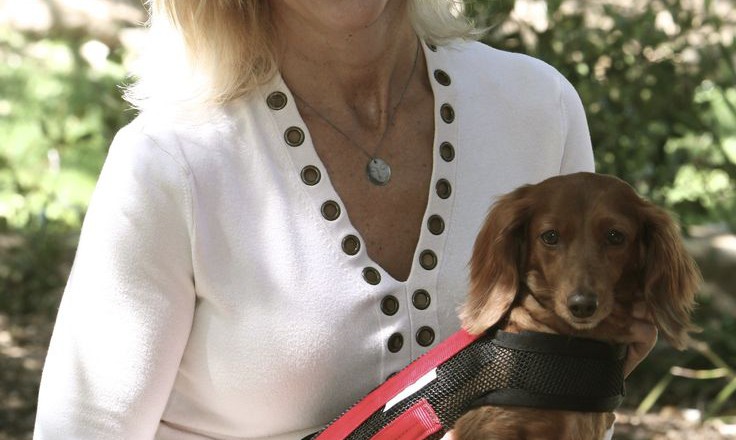
A guest blog by Lisa Luckenbach of WiggleLess back braces
Hello everyone! I am so happy for the opportunity to serve as a guest blogger on Dr. Pete’s blog! I love sites like petethevet.com, because resources like this are godsends for the times you see your pet in need of help but you don’t know the best way of providing it. Even though I have owned animals for nearly all of my life, my pets never cease to find ways to surprise me in so many ways, and every now and again I’ll see something in them that I’ve never encountered before.
Such a thing happened to me a few years ago with one of my dogs, June. To say that June was playful was an understatement! She was a vibrant, rambunctious little Dachshund that shared my love for hiking, swimming and doing anything outdoors. Earlier in her life, June was as fearless as she was tireless. She was always eager to walk that extra mile, swim that extra lap, jump a little higher and do a little more — until it began putting her health at risk.
At age 3, June had already experienced one or two back-related injuries but her restless and waggly nature only prolonged her recovery time. During one particular recovery period, I noticed the happy, eager pup I once knew became something different entirely — a victim of her own body. June’s whole physicality had changed – she was hunched over, visibly tense, she whined constantly and always seemed to be anxious. Even when the vet declared her out of the woods recovery-wise, June still seemed to struggle. Being the proactive pet parent that I am, I jumped on my computer and did a search for her symptoms and eventually found a possible culprit, which our vet later confirmed: IVDD, or Intervertebral Disc Disease.
IVDD is an ailment in which the supporting discs between vertebrae bulge or rupture into or around the spinal cord. These discs ultimately put pressure on the nerves running through the spinal cord causing pain, nerve damage, and other maladies. IVDD is extremely common in chondrodystrophic breeds, or dogs whose normal cartilage development has been altered via generations of breeding for the purpose of a stout, usually shorter appearance. Examples of breeds include dachshunds, beagles, bulldogs, corgis, pugs, basset hounds, and poodles. While chondrodystrophic breeds are prone to the disease, IVDD is not exclusive to these types of dogs and disc degeneration can present in dogs as young as 6 to 12 months.
Other symptoms of IVDD include:
-
Pain or stiffness in the back or neck
Change in stance or posture (for instance, an arched or hunched back)
Lack of coordination
Impaired or complete lameness in one or more limbs
Reluctance to walk, rise, or play
Sudden general weakness when moving
Changes in urination, specifically a loss of bladder control
There are two types of disc disease: Type I and Type II. With Type I, a disc’s outer layer calcifies or hardens, causing it to become brittle and more prone to breakage when met with sudden, forceful impacts. When this happens, part of the disc bursts and causes its inner material to press into the spinal cord and the nerves within in. Type II, on the other hand, usually presents itself during a dog’s later years (usually between ages 8 and 10), as degeneration of the disc occurs over time through everyday wear and tear. Type I is obviously sudden and is usually more painful.
Should you notice one or more IVDD symptoms in your pup, get him evaluated by your veterinarian as soon as possible. When left untreated, IVDD can lead to disc rupture, increased pain, and even paralysis.
IVDD, even when treated can have lifelong effects also, so consistent care is still critical. We constantly worked with June after her diagnosis—regularly engaging her back with calming exercises and massages—we even went so far as to create a specially designed back brace for her, which helped a great deal.
Don’t let IVDD take you by surprise like it did with June and me! With IVDD, like any ailment, proactivity, patience, and persistent care of your pup is key to healthy, happy life.
Tips
Don’t ever ignore any sign that your dog is in pain
Have your dog avoid overexertion or over exercise —especially if he is a smaller breed
Keep your dog at a healthy weight—avoid obesity
AUTHOR BIO: Lisa Luckenbach has developed WiggleLess back braces for dogs that are overweight and need extra support, elderly with aching backs, diagnosed with IVDD-related back problems, or overly active and can benefit from the structure a dog back brace provides. In addition to running WiggleLess, Lisa is a registered yoga instructor, licensed massage therapist, public speaker, ordained minister, and breast cancer survivor. She shares her home with her husband, two teen-aged daughters, seven chickens, and three spunky, adopted dogs, Ryder (Cocker Spaniel), LaVerne (Schnauzer/Doxie mix), and Chai (Doxie/Jack russell mix). Visit wiggleless.com to learn more about Lisa and her back brace for dogs.



Please note that I am unable to answer veterinary questions in comments. If you have questions or concerns about your pet's health it is always better to contact your vet.